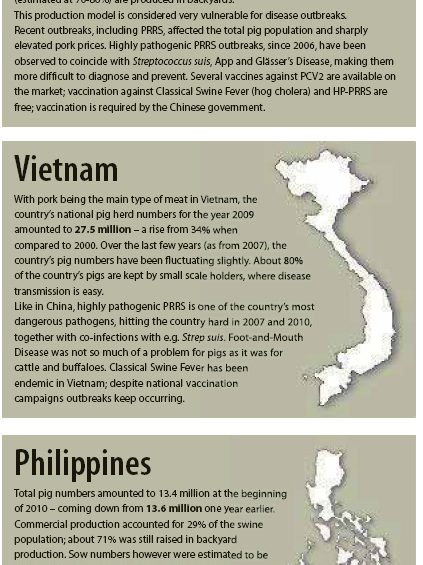Asia: Where profits and pathogens meet

VIV Asia 2011 was a show with a vibrant atmosphere that has never been seen before. The South East Asian pig industries are skyrocketing, especially in Vietnam and China where strong growth figures can be noted. Since more pigs also means increased disease pressure, all major pig producing countries in the Far East have recently stepped up their vaccination programmes and emphasised biosecurity. What is happening where?
If the success of VIV Asia is a good indicator to assess the strength of the Asian livestock business, it helps to take a closer look at the figures of this year’s edition of the trade show, held in Bangkok, Thailand, 9-11 March. Considered a great success, the show attracted a record number of 28,978 visitors. The total figure was a massive increase of 39% on the previous show in 2009 (20,831).
Analysis showed that 56% of the visitor numbers came from abroad (16,264) and 12,714 were from Thailand. The list of the top 10 visitor countries was topped by India, followed by Vietnam and the Philippines. Interest from China is also constantly on the rise and countries like Pakistan, Bangladesh and Sri Lanka now feature among the top 10. As expected, visitor growth from South Korea and Japan was lower. Of the 682 exhibitors at VIV Asia 2011, 246 were there for the first time. Most of the newcomers operate in the feed milling equipment, feed ingredient and animal health sectors. The next edition of VIV Asia will be held 13-15 March, 2013. One third of the 2011 exhibitors have already put their names down for this edition.
Rabobank’s ten year outlook
Kicking off VIV Asia, David C. Nelson, global strategist, Animal Protein, Grains and Oil Seeds at Rabobank, attempted to paint a picture of the next ten years concerning global agriculture, using the topic ‘Focus 2021’.
Feed prices will remain high, Nelson said, as yield improvements are decelerating and the challenge remains to service growing markets. One of the countries that could well profit from this growth could be Brazil, he said. The country had, however, increased its total surface of planted crops by a mere 1% in 2010-2011. Input costs, fertiliser prices, land prices and an unfavourable currency were named as reasons why the message to grow more crops in Brazil was not yet taken up. Nelson also compared Brazil’s Mato Grosso province to the Black Sea region in Ukraine/Russia. Both have high potential, but are relatively landlocked and badly reachable – hence high transport costs need to be added to relatively low costs of cultivation.
At the moment, JBS, Tyson and Smithfield top the ranks of largest meat producers in the world. These companies will be challenged, Nelson mentioned. The last couple of years already saw the rise of the Brazilian conglomerates, and the size of Russian (e.g. Cherkizovo) and Chinese (e.g. Zhongpin) integrators is growing rapidly.Russia’s official policy is to become self-sufficient in protein production, i.e. domestic production will meet domestic demand. Nelson expected Russia to be at 85% in 2015 and at 95% in 2020. “What this means? All meat exporting countries have to find new markets!”
The Chinese market, with approximately 50% of the world’s pigs, may face a shortage of corn stocks and will soon need to import. Official figures may draw a somewhat overly optimistic picture, Nelson said: “China’s corn supplies appear to be desperately low.” He therefore expected strong grain imports in the years to come.
See the boxes in this article for a closer look into the current status of pig production in the six major pig producing countries in Asia – and see where they are heading.
This report has been made possible using the information supplied by six speakers at the Asian Pig Veterinary Society (APVS) Congress: Dr He Qigai (China), Dr Tran Thi Dan (Vietnam), Dr Zoilo M. Lapus (Philippines), Dr Jung Sung-Dae (South Korea), Dr Hirochimi Ishikawa (Japan), Dr Wimolporn Thitisak (Thailand).











